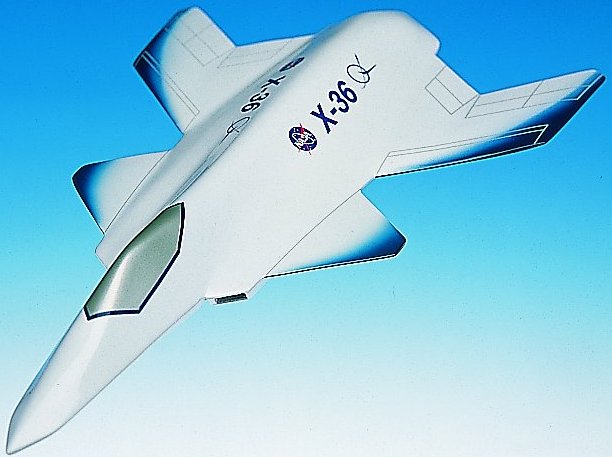|
|
|
Boeing X-36
Prototype Fighter |
The
Boeing Company and the National Aeronautics and Space
Administration (NASA) are teamed to develop a prototype fighter
aircraft designed for stealth and agility. The result--after only
28 months--is a subscale tailless aircraft called the X-36.
The 28-percent scale, remotely piloted X-36 has no vertical or
horizontal tails, yet it is expected to be more maneuverable and
agile than today's fighters. In addition, the tailless design
reduces the weight, drag and radar cross section typically
associated with traditional fighter aircraft. In a series of
upcoming flight tests, the low-cost X-36 research vehicle will
demonstrate the feasibility of using new flight control
technologies in place of vertical and horizontal tails to improve
the maneuverability and survivability of future fighter aircraft.
During flight, the X-36 will use new split
ailerons and a thrust-vectoring nozzle for directional control.
The ailerons not only split to provide yaw (left and right)
control, but also raise and lower asymmetrically to provide roll
control. The X-36 vehicle also incorporates an advanced,
single-channel digital fly-by-wire control system developed with
commercially available components.
Fully fueled, the X-36 prototype weighs 1,300
pounds. It is 19 feet long and measures 11 feet at its widest
point. It is 3 feet high and is powered by a Williams Research
F112 engine that provides about 700 pounds of thrust. Using a
video camera in the nose of the vehicle, a pilot controls the
flight of the X-36 from a virtual cockpit--complete with head-up
display (HUD)--in a ground-based station. This pilot-in-the-loop
approach eliminates the need for expensive and complex autonomous
flight control systems.
Boeing, through the former McDonnell Douglas, has been
working under contract to NASA Ames Research Center, Moffett
Field, Calif., since 1989 to develop the technical breakthroughs
required to achieve tailless agile flight. Based on the positive
results of extensive wind tunnel tests, McDonnell Douglas in 1993
proposed building a subscale tailless research aircraft.
In 1994 McDonnell Douglas and NASA began joint funding of the
development of this aircraft, now designated the X-36. Under the
roughly 50/50 cost-share arrangement, NASA Ames is responsible for
continued development of the critical technologies, and Boeing for
fabricating the aircraft. Boeing has built the X-36
with a combination of advanced, low-cost design and manufacturing
techniques pioneered by the company's Phantom Works
research-and-development operation. |
|

|
X-33 Prototype Fighter
Standard Series. 1/15th scale. 8.75" wingspan x 13.35"
long.
No. AXA5D-ST. Only $139.95 |
|
